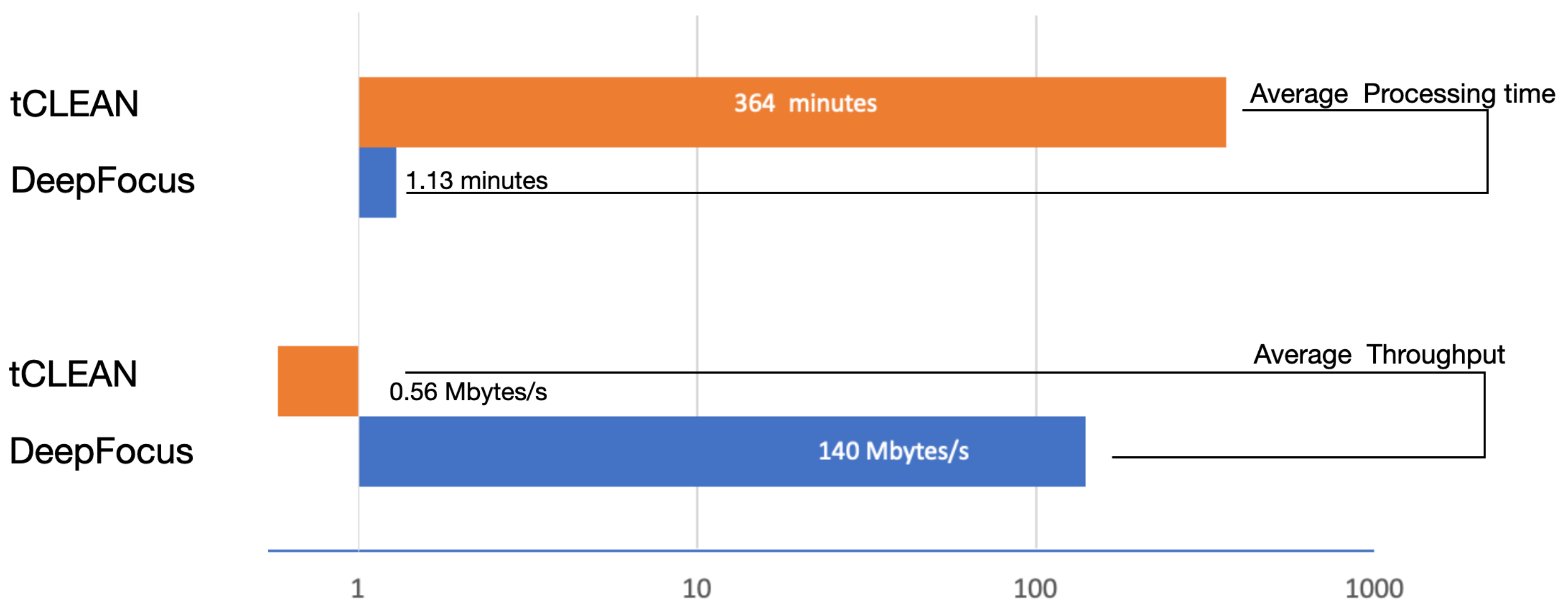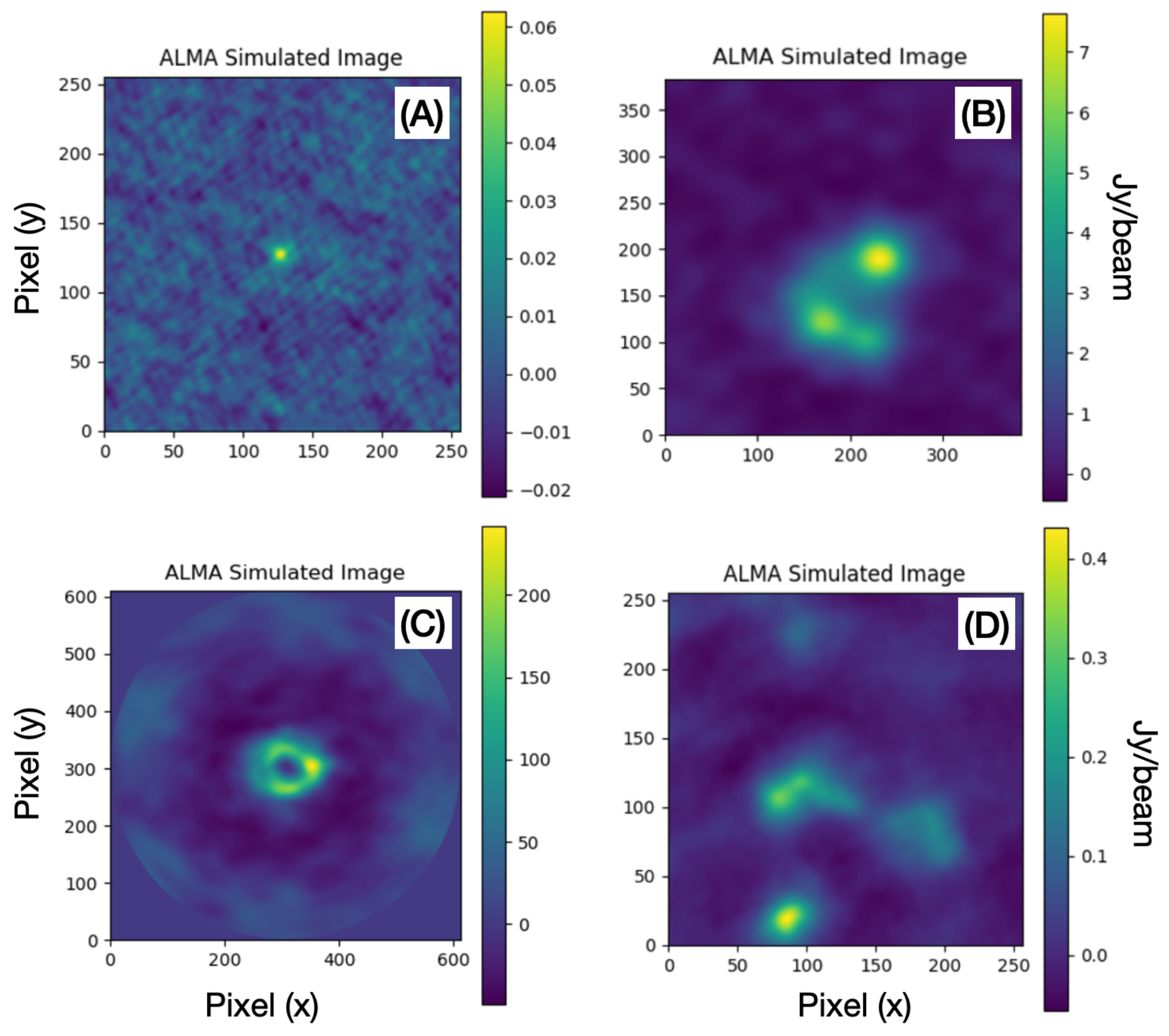A BRAIN Study to Tackle Image Analysis with Artificial Intelligence in the ALMA 2030 Era †
Abstract
:1. Introduction
Data Rate and Data Volume Incrementing with ALMA2030
2. Methods and Results: Artificial Intelligence for Synthesis Imaging with BRAIN
2.1. Resolve
2.2. DeepFocus
Benchmark on Archived ALMA Data Cubes
2.3. A Refined ALMA Simulator: ALMASim
2.3.1. Sharpening Mock Data with Realistic Noise Characteristics
Empirical Noise Modeling
3. Outlook and Conclusions
Author Contributions
Funding
Institutional Review Board Statement
Informed Consent Statement
Data Availability Statement
Conflicts of Interest
Abbreviations
| ALMA | Atacama Large Millimeter/submillimeter Array |
| ALMA2030 | ALMA Development Roadmap |
| BRAIN | Bayesian Reconstruction through Adaptive Image Notion |
| DSHARP | Disk Substructures at High Angular Resolution Project |
| EI | Expected improvement |
| ESO | European Southern Observatory |
| EU ARC | European ALMA Regional Centre |
| IF | Intermediate frequency bandwidth |
| FITS | Flexible Image Transport System |
| GP | Gaussian process |
| GPU | Graphics processing unit |
| HPC | High-performance computing |
| ML | Machine learning |
| MPI | Message Passing Interface |
| NIFTy | Numerical Information Field Theory |
| Probability density function | |
| WSU | Wideband Sensitivity Upgrade |
References
- Wootten, A.; Thompson, A.R. The Atacama Large Millimeter/Submillimeter Array. Proc. IEEE 2009, 97, 1463–1471. [Google Scholar] [CrossRef]
- Carpenter, J.; Iono, D.; Testi, L.; Whyborn, N.; Wootten, A.; Evans, N. The ALMA Development Roadmap. 2018. Available online: https://www.eso.org/sci/facilities/alma/developmentstudies/ALMA_Development_Roadmap_public.pdf (accessed on 23 November 2023).
- Carpenter, J.; Iono, D.; Kemper, F.; Wootten, A. The ALMA Development Program: Roadmap to 2030. arXiv 2020, arXiv:2001.11076. [Google Scholar]
- Carpenter, J.; Brogan, C.; Iono, D.; Mroczkowski, T. ALMA Memo 621: The ALMA2030 Wideband Sensitivity Upgrade. arXiv 2022, arXiv:2211.00195. [Google Scholar]
- Guglielmetti, F.; Villard, E.; Fomalont, E. Bayesian Reconstruction through Adaptive Image Notion. Proceedings 2019, 33, 21. [Google Scholar] [CrossRef]
- Guglielmetti, F.; Arras, P.; Delli Veneri, M.; Enßlin, T.; Longo, G.; Tychoniec, L.; Villard, E. Bayesian and Machine Learning Methods in the Big Data Era for Astronomical Imaging. Phys. Sci. Forum 2022, 5, 50. [Google Scholar]
- Siemiginowska, A.; Eadie, G.; Czekala, I.; Feigelson, E.; Ford, E.B.; Kashyap, V.; Kuhn, M.; Loredo, T.; Ntampaka, M.; Stevens, A.; et al. Astro2020 Science White Paper: The Next Decade of Astroinformatics and Astrostatistics. arXiv 2019, arXiv:1903.06796. [Google Scholar]
- Enßlin, T.A.; Frommert, M.; Kitaura, F.S. Information field theory for cosmological perturbation reconstruction and nonlinear signal analysis. Phys. Rev. D 2009, 80, 105005. [Google Scholar] [CrossRef]
- Junklewitz, H.; Bell, M.R.; Selig, M.; Enßlin, T.A. RESOLVE: A new algorithm for aperture synthesis imaging of extended emission in radio astronomy. Astron. Astrophys. 2016, 586, A76. [Google Scholar] [CrossRef]
- Tychoniec, Ł.; Guglielmetti, F.; Arras, P.; Enßlin, T.; Villard, E. Bayesian Statistics Approach to Imaging of Aperture Synthesis Data: RESOLVE Meets ALMA. Phys. Sci. Forum 2022, 5, 52. [Google Scholar]
- Roth, J.; Arras, P.; Reinecke, M.; Perley, R.A.; Westermann, R.; Enßlin, T.A. Bayesian Radio Interferometric imaging with direction–dependent calibration. Astron. Astrophys. 2023, 678, A177. [Google Scholar] [CrossRef]
- Delli Veneri, M.; Tychoniec, Ł.; Guglielmetti, F.; Longo, G.; Villard, E. 3D detection and characterization of ALMA sources through deep learning. Mon. Not. R. Astron. Soc. 2023, 518, 3. [Google Scholar] [CrossRef]
- Andrews, S.M.; Huang, J.; Pérez, L.M.; Isella, A.; Dullemond, C.P.; Kurtovic, N.T.; Guzmán, V.V.; Carpenter, J.M.; Wilner, D.J.; Zhang, S.; et al. The Disk Substructures at High Angular Resolution Project (DSHARP). I. Motivation, Sample, Calibration, and Overview. Astrophys. J. Lett. 2018, 869, L41. [Google Scholar] [CrossRef]
- Huang, J.; Andrews, S.M.; Pérez, L.M.; Zhu, Z.; Dullemond, C.P.; Isella, A.; Benisty, M.; Bai, X.; Birnstiel, T.; Carpenter, J.M.; et al. The Disk Substructures at High Angular Resolution Project (DSHARP). III. Spiral Structures in the Millimeter Continuum of the Elias 27, IM Lup, and WaOph 6 Disks. Astrophys. J. Lett. 2018, 869, L43. [Google Scholar] [CrossRef]
- Disk Substructures at High Angular Resolution Project (DSHARP). Available online: https://almascience.eso.org/almadata/lp/DSHARP/ (accessed on 23 November 2023).
- The CASA Team. CASA, the Common Astronomy Software Applications for Radio Astronomy. Publ. Astron. Soc. Pac. 2022, 134, 1041. [Google Scholar] [CrossRef]
- Arras, P.; Frank, P.; Haim, P.; Knollmüller, J.; Leike, R.; Reinecke, M.; Enßlin, T. Variable structures in M87★ from space, time and frequency resolved interferometry. Nat. Astron. 2022, 6, 259–269. [Google Scholar] [CrossRef]
- Knollmüller, J.; Arras, P.; Enßlin, T. Resolving Horizon-Scale Dynamics of Sagittarius A★. arXiv 2023, arXiv:2310.16889. [Google Scholar]
- Preuss, R.; von Toussaint, U. Global Optimization Employing Gaussian Process-Based Bayesian Surrogates. Entropy 2018, 20, 201. [Google Scholar] [CrossRef] [PubMed]
- Högbom, J.A. Aperture synthesis with a non-regular distribution of interferometer baselines. Astron. Astrophys. Suppl. 1974, 15, 417. [Google Scholar]
- Oman, K.A. MARTINI: Mock Spatially Resolved Spectral Line Observations of Simulated Galaxies; Bibcode: 2019ascl.soft11005O; Astrophysics Source Code Library: College Park, MD, USA, 2019. [Google Scholar]
- The Illustris Collaboration. 2018. Available online: https://github.com/illustristng/illustris_python (accessed on 23 November 2023).
- The Nifty Team. 2021. Available online: https://gitlab.mpcdf.mpg.de/ift/nifty (accessed on 23 November 2023).
- CNGI. Available online: https://cngi-prototype.readthedocs.io/en/latest/_api/autoapi/cngi/index.html (accessed on 23 November 2023).





Disclaimer/Publisher’s Note: The statements, opinions and data contained in all publications are solely those of the individual author(s) and contributor(s) and not of MDPI and/or the editor(s). MDPI and/or the editor(s) disclaim responsibility for any injury to people or property resulting from any ideas, methods, instructions or products referred to in the content. |
© 2023 by the authors. Licensee MDPI, Basel, Switzerland. This article is an open access article distributed under the terms and conditions of the Creative Commons Attribution (CC BY) license (https://creativecommons.org/licenses/by/4.0/).
Share and Cite
Guglielmetti, F.; Delli Veneri, M.; Baronchelli, I.; Blanco, C.; Dosi, A.; Enßlin, T.; Johnson, V.; Longo, G.; Roth, J.; Stoehr, F.; et al. A BRAIN Study to Tackle Image Analysis with Artificial Intelligence in the ALMA 2030 Era. Phys. Sci. Forum 2023, 9, 18. https://doi.org/10.3390/psf2023009018
Guglielmetti F, Delli Veneri M, Baronchelli I, Blanco C, Dosi A, Enßlin T, Johnson V, Longo G, Roth J, Stoehr F, et al. A BRAIN Study to Tackle Image Analysis with Artificial Intelligence in the ALMA 2030 Era. Physical Sciences Forum. 2023; 9(1):18. https://doi.org/10.3390/psf2023009018
Chicago/Turabian StyleGuglielmetti, Fabrizia, Michele Delli Veneri, Ivano Baronchelli, Carmen Blanco, Andrea Dosi, Torsten Enßlin, Vishal Johnson, Giuseppe Longo, Jakob Roth, Felix Stoehr, and et al. 2023. "A BRAIN Study to Tackle Image Analysis with Artificial Intelligence in the ALMA 2030 Era" Physical Sciences Forum 9, no. 1: 18. https://doi.org/10.3390/psf2023009018
APA StyleGuglielmetti, F., Delli Veneri, M., Baronchelli, I., Blanco, C., Dosi, A., Enßlin, T., Johnson, V., Longo, G., Roth, J., Stoehr, F., Tychoniec, Ł., & Villard, E. (2023). A BRAIN Study to Tackle Image Analysis with Artificial Intelligence in the ALMA 2030 Era. Physical Sciences Forum, 9(1), 18. https://doi.org/10.3390/psf2023009018





